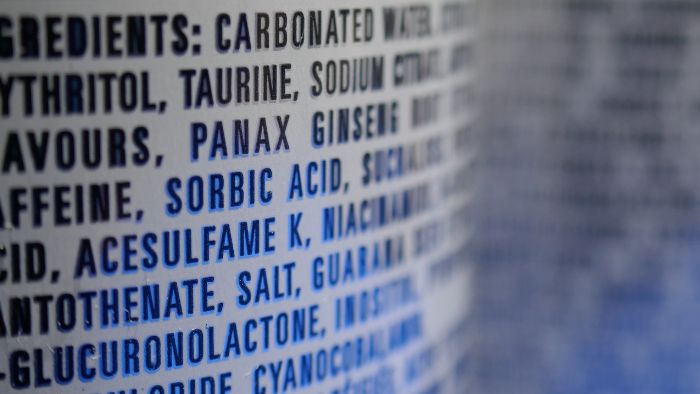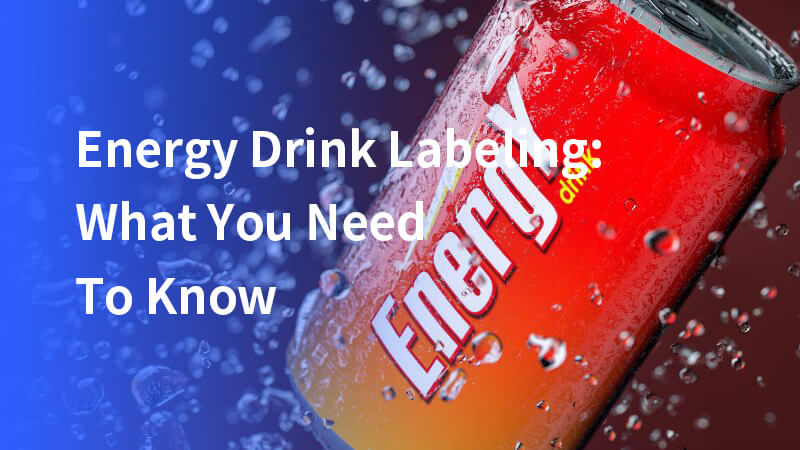Energy drink labeling is undoubtedly one of the most prominent aspects of the beverage market today. In fact, energy drink products could benefit tens of millions of dollars annually from 2021 to the present, with some growth likely thereafter.
Energy drink packaging design is colorful and attention-grabbing (and likely part of their success). Good graphic design for your beverage label that appeals to your target audience can boost your products’ sales, but there are also important legal requirements to consider when you label energy drinks. In order to avoid costly mistakes on your product label, familiarize yourself with the laws and regulations of energy drink labels.
Before you start on your custom label, learn how to navigate mockups and nutrition facts to guarantee success for your energy drink packaging design.

How can you label energy drinks for marketing success?
Good graphic design will help set your energy drink apart from competitors. When it comes to energy drink companies, their target audience tends to skew younger. Typically, energy drink products are purchased by teens and young adults. Keep your audience in mind as you design your beverage label.
Once you know your target demographic, you can begin creating your energy drink design. Consider using vibrant colors, bold fonts, and dynamic imagery that will capture the attention of younger consumers. Additionally, ensure that your label is clear, informative, and complies with all regulatory requirements to avoid any legal issues.
Choosing the right container for your energy drink
First, choose the kind of container for your energy drink. You want to design the energy drink label to fit the container, so you need to know its shape and measurements.
For energy shots, bottles are often the best way to go as there are more appropriate sizing options. For energy drinks, cans are the most common.
Soft drinks, sports drinks, and water come in plastic bottles, and there are some energy drink bottles available at stores. Energy drink cans aren’t the only option for your packaging design.

Energy drink cans, however, are more environmentally friendly and preferred by customers compared to plastic bottles. Using an unusual can size for your energy drink can help distinguish your product from others, such as the skinny can that Red Bull energy drinks first made popular. Additionally, cans offer better protection against light and air, preserving the drink’s flavor and potency.
Designing the perfect product label for your energy drink
The most important component to catch your target audience’s attention is the packaging design. You can hire a graphic designer to handle this element based on your brand’s style if you choose to. There are also templates available online if you choose to design them yourself.
If you choose to design it yourself, here are the components to consider for your custom label:
- Color: If your target audience is younger, bolder and higher contrast colors can help create a sense of excitement.
- Logo: You want to give your brand’s logo a prominent position to grab the eye. Monster energy drink is a great example of this.
- Topography: Simple, easy-to-read text is important but should still match your brand identity. Nutrition Information: Make sure you have space for the nutritional information required by the FDA. We’ll go over what information is required in a moment for your beverage label. Make sure that this is somewhere easy to locate, but not somewhere that distracts from your graphic design.
- Imagery: Use dynamic and appealing images that resonate with your target audience. This can include action shots, energetic visuals, or anything that conveys the vibe of your brand.
Once you have settled on the stylistic elements of your energy drink design, make sure that you test out how it looks. You can do a mockup online or have a limited number of physical mockups produced. Make sure there are no issues with your label design before you put it on the market.
From design to production and application
Once you have the design down, you are ready to begin production and application.
There are a number of different ways to apply product labels. Round cans require different labeling methods than flat surfaces.
Choose a method that keeps your bottle label on firmly so that customers can’t peel it off like a sticker. Quality applications may require specialized machinery, Viallabeller offers beverage labeling solutions and round container labeling solutions with machines that meet these requirements.
Additionally, ensure that the adhesive used for your labels is strong enough to withstand various environmental conditions such as moisture and temperature changes. Testing different application methods and materials will help determine the best solution for maintaining the integrity and appearance of your labels throughout the product’s shelf life.
Understanding FDA Requirements for Energy Drinks
All food and beverages on the market in the United States require nutrition information on their label. Three components must be on beverage labels:
- A list of ingredients
- A declaration of allergens when applicable
- The Nutrition Facts panel

The American Beverage Association (ABA) also suggests that energy drink labels should include extra information to avoid potential liability issues. There are high amounts of caffeine and other stimulants in energy drinks and energy shots, so it is better to include more information than is legally necessary. This helps keep your energy drink products safe from any potential legal issues.
The ABA encourages energy drink labels to include the following:
- Amount of caffeine per serving or per package in addition to the information on the Nutritional Facts Label.
- Warnings that the drink is not recommended for those who are sensitive to caffeine, for children, or for those who are pregnant or breastfeeding.
- An agreement to follow the Council of Beverage Association regarding marketing policies geared towards children.
- Clear labeling that informs consumers that energy drinks are beverages and not dietary supplements.
- Clear labeling to show that the manufacturer does not prompt mixing the energy drink with alcohol or claim that it can help the consumer become sober by drinking it.
- Do not include any promotion or encouragement to drink the energy drink excessively on your label design or in your marketing materials.
Categorizing energy shots as dietary supplements
Manufacturers of energy shots typically categorize them as dietary supplements because most contain more caffeine than the FDA-recommended daily limit of no more than 400 mg.
Energy shot labels are regulated by the Dietary Supplement Health and Education Act (DSHEA), which requires that manufacturers include a Supplement Facts panel on all energy shot labels.
In addition to the Supplement Facts panel, energy shot labels must also include any specific health claims, ingredient lists, and a disclaimer stating that the product is not intended to diagnose, treat, cure, or prevent any disease. Proper labeling ensures compliance with regulations and helps consumers make informed choices.
Conclusion
In conclusion, energy drink labeling plays a crucial role in the marketing and regulatory compliance of your product. From designing eye-catching graphics that appeal to a younger demographic to ensuring the label meets all FDA and ABA requirements, each step is essential for success.
Choosing the right container, testing your designs, and understanding the legalities involved can help your energy drink stand out in a crowded market while avoiding potential legal issues. By following these guidelines, you can create a compelling and compliant label that attracts customers and enhances your brand’s reputation.
